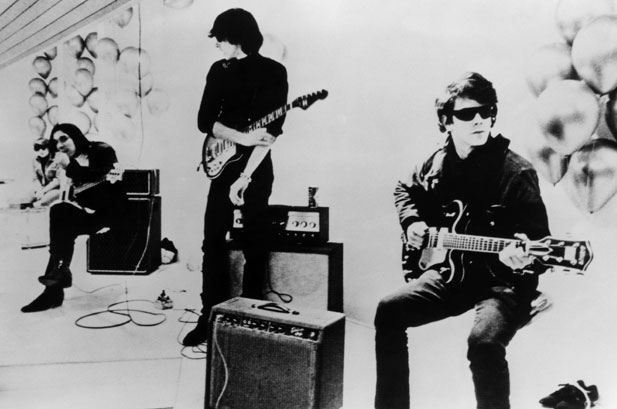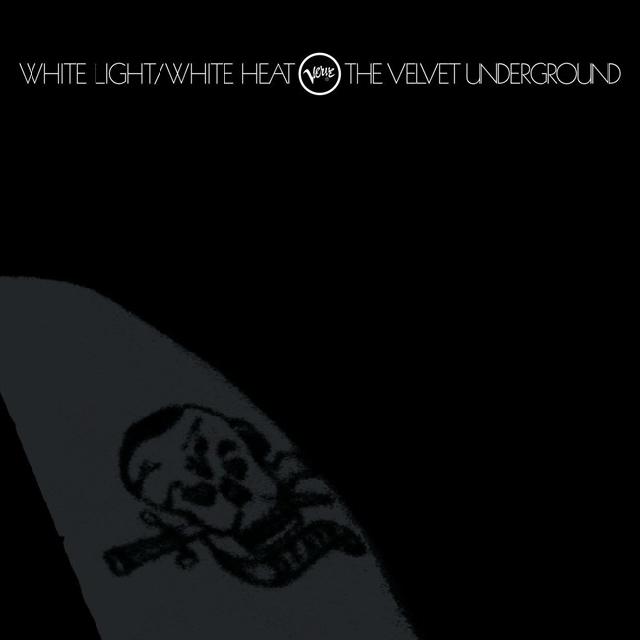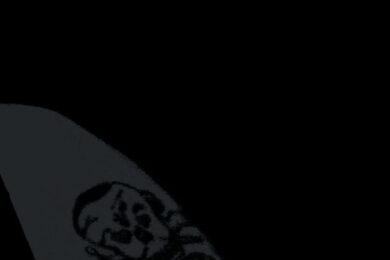Over two or so days in September 1967, The Velvet Underground went into Mayfair Studios in New York City with Producer Tom Wilson, with whom they had worked with before on the sessions for their debut album.
This time around, after frustratingly huge delays in getting that album, The Velvet Underground And Nico released, their association with Andy Warhol having disintegrated and Nico kicked out and left to forge a solo career, their mood was tense. What came from these sessions was the farthest cry from everything they had done before.
Bad live recordings of their previous shows at Exploding Plastic Inevitable events attest to the cacophony and drone drenched three chord extended workouts, but their first album barely scratched the surface of where it was about to go next. What followed was so bent out of shape, you could, quite rightly, feel it was a completely different band.
Sterling Morrison had this to say: "We were all pulling in the same direction. We may have been dragging each other off a cliff, but we were all definitely going in the same direction. In the White Light/White Heat-era, our lives were chaos. That’s what’s reflected in the record."
John Cale has famously described it as "anti-beauty" in reference to their first’s more touching and gentle side.
Tom Wilson reportedly went AWOL during recording because he couldn’t stand the noise. For a man who had previously worked with the prickly and mercurial Dylan, working with Reed and co. must have been a step too far. In fact, White Light/White Heat can reasonably be described as the most apt title for an album ever.
I make no bones about it, this is my favourite Velvets album. I love this record just as much as I did when I first heard it so long ago. It will remain in my list of all time favourites and never be usurped.
It’s an album that divides it’s audience, especially amongst the lovers of the softer Reed driven fourth album Loaded. Well, I don’t care much for Loaded. Never have and probably never will. It’s not terrible, I just don’t like it very much. It’s not a critique of that album, it’s just a personal opinion. Sure, I loved the Banana album and I still do, which to me, being far superior and important than Sgt. Pepper’s… could ever be. I love the third self-titled album in smaller doses, but it’s already becoming the Lou Reed show, aided and abetted by the ever loyal Moe and Sterl, but something had gone that never returned.
White Light/White Heat simply ticks all the right boxes for me. Maybe because Cale dominates it so much and I love John Cale far more than I ever loved Lou Reed. You can feel Cale steer them into much more avant-garde and experimental directions. Classic artistic differences between Reed and Cale are obviously rearing their ugly heads at this time. It’s possibly a power struggle led by ego but it’s this pre-meltdown phase that also attracts me to albums recorded by bands on the cusp of disintegrating. Much like Love’s Forever Changes, Buffalo Springfield’s Again or Big Star’s 3rd, you can sense the splintering that’s occurring. I love the lunacy of this album, the sheer punkishness of it, the grime and the discordant avant-garde mass of noise. I love the fact that nothing else sounds like it – either recorded in that period or since. It really can be described as a true unique artefact of that time. It isn’t as scary or as obnoxious as Metal Machine Music (which I also love), it still strafes everything around it with such hard edged attitude, it can make The Stooges seem like choir boys at times.
I have to state that I haven’t owned previous CD versions before, having seven versions in their varying sleeves and mono/stereo versions on vinyl. Of course, any remastering is most welcome, especially knowing that early CD versions of favourite albums often sound like shit.

So, what do you get here on this 45th Anniversary Edition?
The original black sleeve with Billy Name’s skull and dagger tattoo is faithfully restored after the dubious white Airfix soldiers sleeve or plain black sleeve of reissues of yesteryear for both the CD and Vinyl.
Spread over the three CDs, the now de rigueur remastered stereo and mono mixes, single mixes and outtakes, plus a souped up boot from April 67 recorded at The Gymnasium in NYC (which has been easily available in all the wrong places for years), a booklet with liner notes by the ubiquitous David Fricke and some semi-rare pics and poster repros. Sadly, my review copy was only a press download kit, so I cannot attest to the quality of the packaging, but it looks pretty damn fine in the high quality jpegs, given the original resources must be scant.
Universal always seem to do a pretty good job of making these things affordable without ever going down the overload road of the more boutique packages available at insane prices. You know the ones. Those reissues that are signposted as the second coming but (if you are anything like me) rarely come off the shelf because you live in fear of losing all the inserts or because a mate might borrow it when you agreed on the wrong side of a couple bottles of red, only for it to be returned after the hundredth distraught phone call, looking like it’s been to Hell and back (with something always missing).
Disc one kicks off with a rejuvenated stereo remaster of the album. The thick soup of the original production is thinned slightly and spread further in the stereo spectrum. The low end of Moe Tucker’s drum assault and Cale’s bass now finally finding their place without becoming intrusive. Overall, it is possible now to finally hear some of the more obscured noise layers in all the maelstrom, but really, this has never been a record that hi-fi buffs reach for – by any stretch of the imagination – so fine tuning is left to the bare minimum. This has to sound messy and visceral because that’s what it is all about.
Title track blasts straight to the head, fuzzier than ever before. It may be urban myth; it may be the truth but it has been claimed that everything on this album has a distortion pedal on it. The clunk of Cale’s fuzz bass and the jaunty piano taking up the rhythmic reins with Moe’s military snare and splashing cymbals heading ever upwards to the heart of the matter in the most joyous love song to speed ever recorded. In a flash at 2 minutes and 50 odd seconds, it’s gone, falling over itself into chaos until it bursts at the seams.
‘The Gift’ runs its instrumental funky path in the right channel as always, whilst Cale’s dulcet Welsh dulcet scare up a story of Waldo and his object of desire, that is anything but by the post, in the left. While the spidery lead guitar lines weave and twist with the sharpness of a quick scalpel, the horrors of the bland reveal themselves with a rich twist that never fails to amuse, this will always be an odd mix and so original, I don’t believe anyone has ever tried to occupy the same space since.
Cale again leads the odd into ‘Lady Godiva’s Operation’, with Burroughsian Dr. Benway interjections from Reed, over a layer of rolling drums and more of that spidery guitar fizz and viola that drop in and out towards the end, replaced by heartbeats, deep breaths and whisperings. Three tracks in and it’s become so fucking odd, it’s a waste of time trying to compere this record to anything else from that period – or since. While the Grateful Dead et al had disappeared so far up their acidic behinds on the West Coast, this had become even far out for those on the East.
Someone at their label Verve, must have loved them and supported them, but even such loyalty must have been questioned at this point. More than a few ‘What The Fuck IS THIS?’ circulars must have floated around the offices.
A moment of clarity and an almost return to the prettier side of Reed comes in the form of Here She Comes Now. It’s perfectly placed and brings relief to the nervy edginess that precedes, but that gets blown out of the water wholesale by what follows.
Traditionally, ‘I Heard Her Call My Name’ opens side two of the vinyl original, and it can only be described as screeching mania. It’s a love song, but not one that even the most fervent garage punk band could have cooked up. Double speed Tucker’s drums throttle along while the most insanely ragged atomising lead line howls and hurls itself towards oblivion. The oft quoted “…and then my mind split open” is so deranged, it should have a health warning.
For the remaining 17 mins of the original release, we enter the world of ‘Sister Ray’. Everything that ever needs to be said about this has already been said by others more qualified than me. ‘Sister Ray’ IS. Covered to within of its life – as much as ‘Knocking On Heaven’s Door’, it is in danger of being ignored because everyone is so over familiar with it.
But one listen to Cale’s swirling dervish Vox organ fighting the guitars and winning every time, means you can’t simply dismiss it simply as a song covered by every one who wants to jam noisily.
While other bands at that time looked at long jams as a chance to impress, the Velvets just used it to alienate and indulge massively in flippin’ the bird at all those around them. Nothing says ‘Fuck you’ quite like ‘Sister Ray’. It is also quite certainly the seed that grew into the more noisy and agitated end of Krautrock, more than anything else.
So, when that particular firestorm finishes, you have the end of one of the greatest noise records ever made, in 1968. So far ahead of it’s time, has anything caught up with yet? Maybe.
But at the time of writing, I’m struggling to think of anything.
So, we now enter EXTRAS city. It continues with a softer, more reverb drenched alternate mix of ‘I Heard Her Call My Name’. It lacks the visceral bite of the original, the stereo is reversed for the most part of the mix with the guitars. Listening to it, you can understand why it was discarded in favour of the mix we know and love, it’s worth is of course as a rare document that it appeals most to die-hards.
An instrumental ‘Guess I’m Falling In Love’, the only genuine outtake from the WL/WH sessions, glides along in it’s chunky blues, with some great fuzz rhythm by Sterling Morrison, who i will always say of as being the greatest underrated rhythm guitar player of all time.
Temptation Inside Of Your Heart finds its place here only for its timing in recording – a few months later in February 1968. Lou and Sterl have fun and giggles and it’s always a joy to hear, but it seems so out of place in context of what we have just been through, it becomes merely a footnote, whereas before, it was amongst other rarities that felt more coherent. Maybe all the extras should have had their own disc to not conflict with the original running order and feeling of WL/WH. ‘Stephanie Says’, also from the same session as ‘Temptation’, points the way to VU’s 3rd and again, simply feels out of place here too, even though it is, of course, splendid.
Two versions of ‘Hey Mr. Rain’ follow, again recorded after the WL/WH sessions, but mixed in 2013. The first allowing Cale’s viola to soar great tonal heights, the second much faster and looser, with blasts of white noise breaking into the mix, altogether giving the listener much more of a feeling of what it must have been like to see the Velvets live after the rush of WL/WH.
A demolishing first run through ‘Beginning To See The Light’ officially ends Cale’s involvement before Doug Yule replaces him. It’s rough around the edges and sounding like it could have escaped from the Live In 1969 rehearsals.
Disc two is the Mono version of WL/WH and although it’s great to hear it as a more solid chunk, the mixes don’t vary from the stereo versions. I believe it was more of a British preserve to make very different mixes of songs in Mono and Stereo back in the day. Having both Mono and Stereo versions on vinyl, it came as little surprise and the remastering adding very little if truth be told. A difference can be heard in the Mono single mixes of ‘WL/WH’ and ‘Here She Comes Now’, but it’s slight. Two versions of ‘The Gift’ simply strip each other of the rival channel i.e. one vocal, one instrumental track.
Disc three features for the first time (officially) a full version of a popular bootleg Live At The Gymnasium, from April 1967. It’s a great transitional period from the first album and from five months before they enter the studios to record WL/WH, it’s a rare document to be sure. Cavernous in sound due to the recording, no remastering in the world could really improve it much more than clean it up of tape warbles and clicks from bad vinyl copies of versions I’ve heard before. It still drops out all over the shop and sounds comparatively weak compared to what was actually heard by the audience at the time I’m sure. It does have many fine moments however. Both ‘Sister Ray’ and an instrumental take on ‘The Gift’ break down into great passages of abstract noise that break out of the sonic limitations of the original recording. I guess it’s a case of turning it up very loud. Much like The Quine Tapes, it’s for completists and although it’s great to hear the most complete version ever, I cannot imagine it’s going to be on constant rotation for anyone.
All in all, this is a great package and if like me, you have avoided previous CD reissues, I’d say it’s a winner purely for WL/WH alone. Most importantly, if it gets into the hands of someone who has never heard such a revolutionary and revelatory recording before, then it’s one for an Xmas list.
White Light/White Heat is out now. Loop have a busy schedule next year. Visit Soundheads.org for more details



